|
(Table 5)
A. Intervals
Signs from Table 5 A.
 Second Second
 Sixth Sixth
 Third Third
 Seventh Seventh
 Fourth Fourth
 Octave Octave
 Fifth Fifth
5-1. "In chords in which the notes are of equal value, one note only is written.
The others are indicated by their intervals from that note--soprano, alto, violin,
viola, right hand for piano, organ and harp--the upper note is written and the
lower notes are expressed by descending intervals.
"In the lower series--tenor, bass, violoncello, and left hand for piano,
organ and harp--the lowest note is written and the others are expressed by
ascending intervals."
Musical Notation for the Blind, British and foreign Blind Assoc., London, 1888
5-2. The quotation above, from the document known as the "Cologne Key", established
the directions for reading and writing intervals; and the meeting itself established
the tradition of the international work that continues today.
Signs from Table 15 A.

 Right hand part Right hand part

 Left hand part Left hand part
Example 5-2  .
.
5-3. Intervals larger than an octave are written with the same series of signs plus an
appropriate octave mark. A ninth is shown with the interval of a 2nd in the new octave,
a tenth is a third in the new octave, ect.
Example 5-3 
5-4. A prime or unison is written by preceding the sign for an octave interval with the
octave mark showing it is sounded at the same pitch as the note itself.
Example 5-4. 
5-5. If more than one interval follows the written note, no octave mark is necessary unless
two adjacent intervals are an octave or more apart.
Example 5-5. 
5-6. When written notes of chords are dotted, the dots are placed immediately
after the notes as in Examples 5-3 and 5-5. Intervals have the same value as written
notes.
5-7. The melodic intervals of the written notes determine whether or not an octave
mark is necessary before each chord.
Example 5-7. 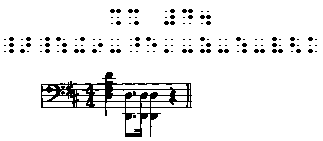
5-8. If there are more than 3 identical intervals in a row, they may be doubled. The interval sign
is written twice after the first note. The following notes of that series are written without intervals,
and the series is closed by writing its interval or intervals once after the last note. An accidental
before any doubled interval except an octave makes it necessary to interrupt the series.
Example 5-8.
(a)
Example 5-8. 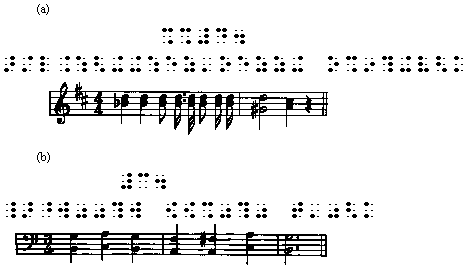
5-9. In a passage of doubled octaves the doubling need not be interrupted by the occurrence of
accidentals at the interval of an octave. In some countries, accidentals are not included before
an octave interval, only before the written note of an octave. Other countries mark all accidentals
as they appear in print.
Example 5-9. 
5-10. A change of clef within a part or voice should not cause a change to the direction in which
intervals are written.
B. In-accords
Signs from Table 5 B.
  Full-measure in-accord Full-measure in-accord
  Part-measure in-accord Part-measure in-accord
  Measure division for part-measure in-accord Measure division for part-measure in-accord
5-11. When all of the harmonic parts do not change at the same time, they are shown by dividing
the measure into voices of like value and presenting two or more sections of the measure "in-accord" or "with" each other. When the entire measure is divided, the full-measure in-accord is used.
5-12. The octave mark must be shown for the first note after an in-accord and at the beginning of
the next measure, whether or not that measure contains an in-accord.
5-13. The order in which the parts are written is the same as the direction of intervals. In treble
parts the top voice is written first; in bass parts the bottom voice is written first.
Example 5-13.
(a) 
(b) 
5-14. In some formats intervals may be doubled in an in-accord part, and the doubling may be carried
over into the same voice of succeeding measures as long as the same number of voices continues.
Example 5-14. 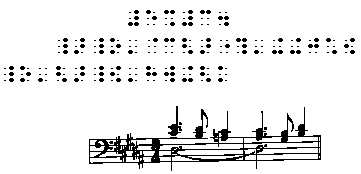
5-15. Accidentals in one voice do not carry over to the in-accord part. Most countries feel they must
be re-marked in the other part and preceded by dot 5 to indicate the accidental does not appear in the
print copy.
Example 5-15. 
5-16. Rests must occasionally be added to an in-accord part. These also should be preceded by dot 5.
Example 5-16. 
5-17. If only part of a measure needs an in-accord, the part-measure in-accord sign is used along with a
sign to show which section of the measure is affected by the in-accord.
5-18. As with the full-measure in-accord sign, the first note following either of these signs must have an
octave mark. If the in-accord occurs at the end of the measure, the first note of the next measure also must
have an octave mark.
Example 5-18. 
5-19. As with the full-measure in-accord, accidentals or rests must be re-marked (and preceded by dot 5)
if they occur in another in-accord voice.
5-20. Some measures may require more than two in-accord parts.
Example 5-20. 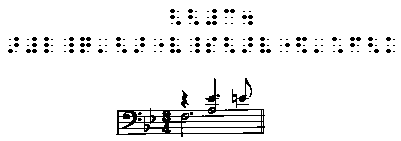
5-21. Full- and part-measure in-accords may be used in the same measure.
Example 5-21. 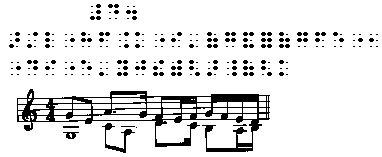
C. Moving-notes
5-22. Another way of showing interval changes that do not occur in all parts at the same time is through
the use of moving-note signs.
Signs from Table 5 C.
 Moving-note sign for one interval Moving-note sign for one interval
 Moving-note sign for two or more intervals Moving-note sign for two or more intervals
5-23. When two, or at most three, notes of equal value move below or above a longer note, they can
be written as intervals separated by dot 6.
5-24. In the following example the first two intervals represent half notes and the remaining
intervals represent quarter notes.
Example 5-24. 
5-25. The moving-note sign can also be used when two or more intervals move together in a similar
manner, but in this case dots 5-6 are substituted for dot 6.
Example 5-25. 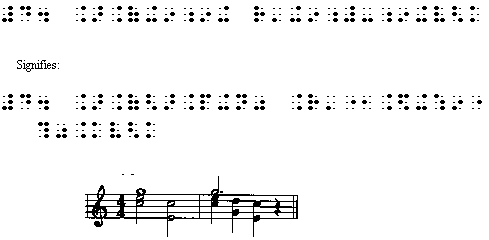
5-26. The use of octave marks in the moving part is governed by the rules for intervals, par. 1-10.
Compare (a) and (b) below.
Example 5-26. 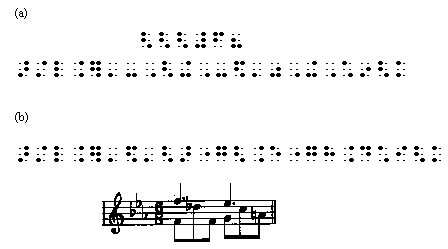
5-27. When an accidental modifies a moving note, the appropriate moving-note sign precedes the
accidental as in Example 5-26(a).
5-28. The moving-note sign may be useful to vocal conductors. When there are complications
of fingering, phrasing, and nuances, it becomes unsuitable for instrumental and keyboard music.
5-29. Tone clusters are discussed under Chapter XIII, Modern Notation.
D. Stem signs
5-30. An additional stem placed on a note or chord may indicate a prime or unison (Example 5-4),
one voice that becomes an in-accord (Example 5-20) or a note to be held while a rhythmic pattern
continues. In the last case, when an in-accord is not satisfactory, stem signs are used to
indicate value. When a note has two stems of different value, the smaller value is written as a
note, and the larger value is written as a stem sign.
Signs from Table 5 D.
  Whole "stem" Whole "stem"
  Half stem Half stem
  Quarter stem Quarter stem
  8th stem 8th stem
  16th stem 16th stem
  32nd stem 32nd stem
5-31. Stem signs are placed after the notes to which they belong and may not
be separated from them by the music hyphen. These signs may be dotted in the same way as written notes,
and they may be modified by slurs, ties and nuances.
Example 5-31. 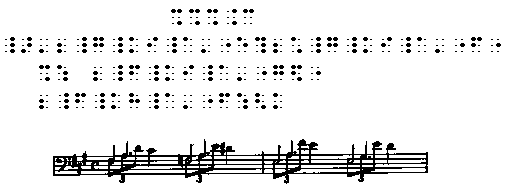
|